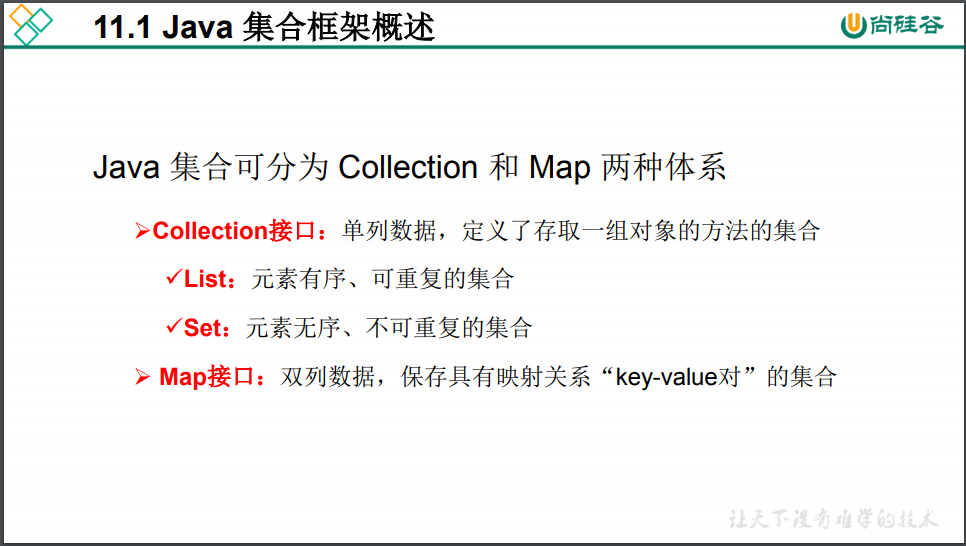




package com.atguigu.java2;
import org.junit.Test;
import java.util.ArrayList;
import java.util.Collection;
import java.util.Date;
/**
* 一、集合框架的概述
*
* 1.集合、数组都是对多个数据进行存储操作的结构,简称Java容器。
* 说明:此时的存储,主要指的是内存层面的存储,不涉及到持久化的存储(.txt,.jpg,.avi,数据库中)
*
* 2.1 数组在存储多个数据方面的特点:
* > 一旦初始化以后,其长度就确定了。
* > 数组一旦定义好,其元素的类型也就确定了。我们也就只能操作指定类型的数据了。
* 比如:String[] arr;int[] arr1;Object[] arr2;
* 2.2 数组在存储多个数据方面的缺点:
* > 一旦初始化以后,其长度就不可修改。
* > 数组中提供的方法非常有限,对于添加、删除、插入数据等操作,非常不便,同时效率不高。
* > 获取数组中实际元素的个数的需求,数组没有现成的属性或方法可用
* > 数组存储数据的特点:有序、可重复。对于无序、不可重复的需求,不能满足。
*
* 二、集合框架
* |----Collection接口:单列集合,用来存储一个一个的对象
* |----List接口:存储有序的、可重复的数据。 -->“动态”数组
* |----ArrayList、LinkedList、Vector
*
* |----Set接口:存储无序的、不可重复的数据 -->高中讲的“集合”
* |----HashSet、LinkedHashSet、TreeSet
*
* |----Map接口:双列集合,用来存储一对(key - value)一对的数据 -->高中函数:y = f(x)
* |----HashMap、LinkedHashMap、TreeMap、Hashtable、Properties
*
*
* 三、Collection接口中的方法的使用
*
* @author shkstart
* @create 2019 下午 4:08
*/
public class CollectionTest {
@Test
public void test1(){
Collection coll = new ArrayList();
//add(Object e):将元素e添加到集合coll中
coll.add("AA");
coll.add("BB");
coll.add(123);//自动装箱
coll.add(new Date());
//size():获取添加的元素的个数
System.out.println(coll.size());//4
//addAll(Collection coll1):将coll1集合中的元素添加到当前的集合中
Collection coll1 = new ArrayList();
coll1.add(456);
coll1.add("CC");
coll.addAll(coll1);
System.out.println(coll.size());//6
System.out.println(coll);
//clear():清空集合元素
coll.clear();
//isEmpty():判断当前集合是否为空
System.out.println(coll.isEmpty());
}
}

package com.atguigu.java;
import org.junit.Test;
import java.util.ArrayList;
import java.util.Arrays;
import java.util.Collection;
import java.util.List;
/**
* Collection接口中声明的方法的测试
*
* 结论:
* 向Collection接口的实现类的对象中添加数据obj时,要求obj所在类要重写equals().
*
* @author shkstart
* @create 2019 上午 10:04
*/
public class CollectionTest {
@Test
public void test1(){
Collection coll = new ArrayList();
coll.add(123);
coll.add(456);
// Person p = new Person("Jerry",20);
// coll.add(p);
coll.add(new Person("Jerry",20));
coll.add(new String("Tom"));
coll.add(false);
//1.contains(Object obj):判断当前集合中是否包含obj
//我们在判断时会调用obj对象所在类的equals()。
boolean contains = coll.contains(123);
System.out.println(contains);
System.out.println(coll.contains(new String("Tom")));
// System.out.println(coll.contains(p));//true
System.out.println(coll.contains(new Person("Jerry",20)));//false -->true
//2.containsAll(Collection coll1):判断形参coll1中的所有元素是否都存在于当前集合中。
Collection coll1 = Arrays.asList(123,4567);
System.out.println(coll.containsAll(coll1));
}
@Test
public void test2(){
//3.remove(Object obj):从当前集合中移除obj元素。
Collection coll = new ArrayList();
coll.add(123);
coll.add(456);
coll.add(new Person("Jerry",20));
coll.add(new String("Tom"));
coll.add(false);
coll.remove(1234);
System.out.println(coll);
coll.remove(new Person("Jerry",20));
System.out.println(coll);
//4. removeAll(Collection coll1):差集:从当前集合中移除coll1中所有的元素。
Collection coll1 = Arrays.asList(123,456);
coll.removeAll(coll1);
System.out.println(coll);
}
@Test
public void test3(){
Collection coll = new ArrayList();
coll.add(123);
coll.add(456);
coll.add(new Person("Jerry",20));
coll.add(new String("Tom"));
coll.add(false);
//5.retainAll(Collection coll1):交集:获取当前集合和coll1集合的交集,并返回给当前集合
// Collection coll1 = Arrays.asList(123,456,789);
// coll.retainAll(coll1);
// System.out.println(coll);
//6.equals(Object obj):要想返回true,需要当前集合和形参集合的元素都相同。
Collection coll1 = new ArrayList();
coll1.add(456);
coll1.add(123);
coll1.add(new Person("Jerry",20));
coll1.add(new String("Tom"));
coll1.add(false);
System.out.println(coll.equals(coll1));
}
@Test
public void test4(){
Collection coll = new ArrayList();
coll.add(123);
coll.add(456);
coll.add(new Person("Jerry",20));
coll.add(new String("Tom"));
coll.add(false);
//7.hashCode():返回当前对象的哈希值
System.out.println(coll.hashCode());
//8.集合 --->数组:toArray()
Object[] arr = coll.toArray();
for(int i = 0;i < arr.length;i++){
System.out.println(arr[i]);
}
//拓展:数组 --->集合:调用Arrays类的静态方法asList()
List<String> list = Arrays.asList(new String[]{"AA", "BB", "CC"});
System.out.println(list);
List arr1 = Arrays.asList(new int[]{123, 456});
System.out.println(arr1.size());//1
List arr2 = Arrays.asList(new Integer[]{123, 456});
System.out.println(arr2.size());//2
//9.iterator():返回Iterator接口的实例,用于遍历集合元素。放在IteratorTest.java中测试
}
}
来源:https://www.cnblogs.com/zhuxiang1029/p/12397110.html
